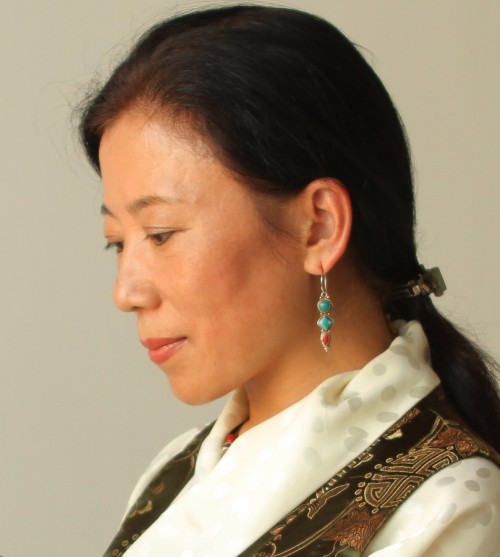Woeser, a Lighthouse for Tibetans
by Tienchi Martin-Liao / August 15, 2012 / 3 Comments
As Tibetans react to Chinese oppression with self-immolation, a writer records their stories.

Tibetan writer Tsering Woeser tells the stories of self-immolated monks. Photo: courtesy of Tienchi Martin-Liao
“Life will never be the same after March 14, 2008,” Weise, the Tibetan poet and writer, said sadly. She grew up in the Kham area of Sichuan province, and when she speaks Chinese it has a slight touch of the Sichuan dialect. Weise’s real name is Tsering Woeser, and she is internationally known for her writing. For years she has used her fearless pen to report the situation in Tibet and write about the fate of her countrymen and women. Although granted many international awards, Woeser has never been to a foreign country. She is not allowed to leave China to personally accept the honors. Instead, she has become a kind of hostage like Liu Xiaobo, Ai Weiwei, and others. But she is also a symbol, a lighthouse, for many of her countrymen. She has a blog where she follows the stories of the immolated monks, where readers can find hows, whens, and a singular why behind their actions.

- During the Cultural Revolution, people were sentenced to death or outright murdered because of one wrong sentence. In China today writers do not lose their lives over their poems or articles; however, they are jailed for years. My friend Liu Xiaobo for example will stay in prison till 2020; even winning the Nobel Peace Prize could not help him. In prison those lucky enough not to be sentenced to hard labor play “blind chess” to kill time AND TO TRAIN THE BRAIN NOT TO RUST. Freedom of expression is still a luxury in China. The firewall is everywhere, yet words can fly above it and so can our thoughts. My column, like the blind chess played by prisoners, is an exercise to keep our brains from rusting and the situation in China from indifference.

- Tienchi Martin-Liao is the president of the Independent Chinese PEN Center. Previously she worked at the Institute for Asian Affairs in Hamburg, Germany, and lectured at the Ruhr-University Bochum from 1985 to 1991. She became head of the Richard-Wilhelm Research Center for Translation in 1991 until she took a job in 2001 as director of the Laogai Research Foundation (LRF) to work on human rights issues. She was at LRF until 2009. Martin-Liao has served as deputy director of the affiliated China Information Center and was responsible for updating the Laogai Handbook and working on the Black Series, autobiographies of Chinese political prisoners and other human rights books. She was elected president of the Independent Chinese PEN Center in October 2009 and has daily contact with online journalists in China.
As a result of the uprising in 2008, the living conditions for the people in Tibet have worsened. The Chinese government has adopted much stricter forms of control and suppression, which have indirectly lead to self-immolations as the Tibetan population feels that they are in an inextricable situation. The pain and rage that Tibetans feel under Chinese occupation is strong enough to result in self-sacrifice.
On February 27, 2009 the first case of self-immolation happened when Tapey (Lobsang Tashi), a 20 year-old monk in the Kriti monastery in Ngaba, set himself on fire. But he did not die because of his burns—the Chinese military shot him down. Two years later, the scene was repeated when Phuntsog, another monk from the same monastery, did the same. He also did not die from the fire. He was beaten to death by the military police.
Since then there have been 49 cases of self-immolation—46 in Tibet, three outside—at the cost of 37 human lives. Woeser collects the stories of the dead, their last words and voices. She has found materials for 12 of them. Some left letters behind, while others recorded their final message onto tape: When living in such a suppressed and humiliating situation, death is as enjoyable as life. Their common wish is for the beloved Dalai Lama to return home. And although the Dalai Lama has called on Tibetans to abandon self-immolation, his requests have been in vain. Tibetans, who otherwise follow the words of their Holiness the Dalai Lama, do not obey him this time. Instead they choose a tragic and heroic, yet non-violent way, to protest and express their deep dismay.
How desperate must be the living circumstances in the towns! In Lhasa for example, there are police and soldiers everywhere. After March 2008, video cameras were installed on the main street. Big Brother is watching with high-tech equipment. The police carry machine guns and truncheons, and in their pocket, a cell phone or iPad. Recently they have taken to carrying fire extinguishers on their backs—not to save lives, but to prevent pictures of the person on fire from being disseminated online. Photos like that damage China’s image.
Lots of the self-immolated people are monks because the “Patriotic movement” has taken over all the monasteries in the Autonomous Region as well as in Kham and Ando. This political campaign started in 1995, but after 2008 it became unendurable. As part of the movement the Chinese national flag must be hoisted and the portraits of the “big Four”—Mao Zedong, Deng Xiaoping, Jiang Zemin, and Hu Jintao—need to be hung in each temple. Very soon the “big Four” will turn to the “big Five” as Xi Jinping will be added.
Meanwhile the picture of Dalai Lama is forbidden.
Security police, working groups, and firemen are also stationed in temples and monasteries. The proportion is almost one to one. Monks are forced to learn “politics” and fill out questionnaires about their attitude towards the Dalai Lama. Personal archives have been set up and details of the monks’ physical characteristics are recorded meticulously: A broken tooth, nearsightedness, a big nose, or high cheek bones all are in the files. Family history and school records too. It is important that each monk and nun can be identified quickly. Cameras have also been installed as 24-hour monitors, with no corner left unwatched. The pressure under which the monks and nuns suffer is indescribable and explains why they form a large portion of the self-immolations.
Woeser updates her blog every day. One day she posted about the latest self-immolation, a 20 year-old man named Ngawang Norphel. She also wrote about the April 6th double immolation of an uncle and his niece, the 45 year-old Lama, Chugu Tudeng, and the 23 year-old nun, Ani Aze.
“How can you keep all of these terrible stories in your mind and not get ill?” I asked Woeser.
“Maybe I am a Tibetan and a Buddhist,” she muttered.
But the Chinese authority does not think so. In their eyes this delicate woman is dangerous and her blog has been attacked and shut down frequently. Therefore Woeser was told that she had to leave her home in Beijing before the CCP’s 18th Party Congress, although her house is already monitored by police day and night. Woeser obeys the “order” silently. Beijing is not her true home anyway—it is too political and the power struggle inside the Zhongnanhai wall constantly shakes and rattles the city. “I am not unhappy,” she said, “that I can avoid all this and go back to the Tibetan plateau for two months or more.” Well, there are police and soldiers patrolling Lhasa too, but Woeser can stay with her mother and family, and her husband Wang Lixiong can visit her from time to time, bringing the newest political jokes from the capital city.





3 Comments on "Woeser, a Lighthouse for Tibetans"
I am trying my best to follow the Tibetan movement but sadly, I don’t really find much meaning and concerted effort being made towards achieving anything worth the name. Is it because the Tibetans are spread and sprinkled around the globe and not being able to unite physically, intellectually and religiously to forge ahead? Or is it because the elderly are too old to matter, the middle level are too few and the youngsters don’t much really care? My personal view is these questions must be answered by the Tibetans themselves honestly, truthfully and regroup seriously to make a difference. It’s not much use to listen to people expressing solidarity by word of mouth which has been going since Chinese takeover. The world bodies give the same empty words, the US, UK, the UN and the EU are all self serving and literally scared of China to do anything about the plight of the Tibetans! So it’s the Tibetans themselves that they must come to terms with realities and chart a new course totally different from what has been done, not much to show for it actually, and wake up!
Trackbacks for this post